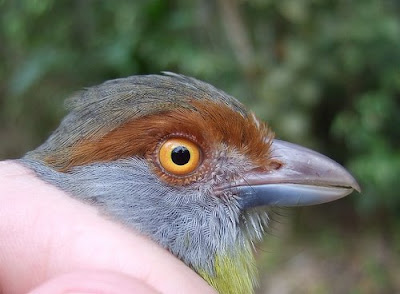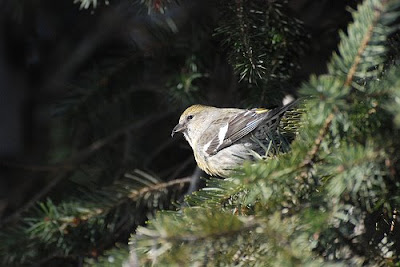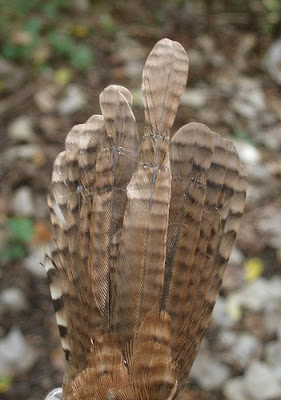Even more so than the areas we visited in Panama last year, Finca Esperanza Verde and other shade coffee farms are critical to preserving biodiversity of birds and other wildlife in Nicaragua. We were stunned at the deforestation. It's not due to human development, but to agriculture (mostly non-commercial) and cattle grazing. Shade coffee farms appeared to be one of the only land uses that preserved a lot of trees.
During our brief stay, we counted well over 100 species, including nearly two dozen species of migratory songbirds that breed in North America but winter in the tropics. Over 30 species of migrant songbirds have been recorded at the finca, and the overall bird list is approaching 300 species.We observed or banded several species new to the finca ourselves. We banded about 70 birds of over 30 species at Finca Esperanza Verde. For most of the time, we were banding right in the coffee production area.
taller native trees providing shade and habitat.
 You know you're off to a good start when the
You know you're off to a good start when thefirst bird you band is a Collared Trogon
(Trogon collaris).
The most common North American migrants banded at FEV are Yellow-bellied Flycatcher, Wood Thrush, Worm-eating Warbler, Wilson's Warbler, Kentucky Warbler, and Ovenbird. Although we captured multiple individuals of those species, we rarely if ever saw the other species, with the exception of Wood Thrushes, in our birding walks through the finca. On the other hand, Baltimore Orioles, Chestnut-sided Warblers, and Tennessee Warblers were very common in the coffee production areas, but we didn't capture any. This underscores how well banding supplements surveys for censusing an area. Other common North American migrants included Black-throated Green Warbler, Black-and-white Warbler, and Summer Tanager. The species I've listed in bold are among the 25 priority species targeted by the MoSI program.
 Wood Thrushes (Hylocichla mustelina) are the most commonly banded birds at the finca -- migrant or resident.
Wood Thrushes (Hylocichla mustelina) are the most commonly banded birds at the finca -- migrant or resident.Although a limited number of birds have been banded at FEV, especially compared to stations operating for more days per year, between-year recaptures are beginning to occur. North American migrants which have returned to the same tiny areas to spend the winter include Wood Thrush, Wilson's Warbler, Louisiana Waterthrush, and Kentucky Warbler. The fact that these birds are showing strong wintering site fidelity emphasizes the importance of habitat preservation in the tropics. By extension, it also suggests that shade coffee is providing habitat that is worth "coming back to" for these migrants, and that the habitat quality is sufficient that the birds were in good enough shape on departure to survive their northbound journey and consequently return the following year.
 Wilson's Warbler (Wilsonia pusilla), a species
Wilson's Warbler (Wilsonia pusilla), a speciesshowing wintering site fidelity at the finca,
being recaptured in multiple winters. We
also found them common in shade coffee farms in
Panama.
 Resident birds are being recaptured between winters,
Resident birds are being recaptured between winters,too. Here Curtis shows off a recaptured Spot-
breasted Wren -- he banded this bird
himself at FEV two years previously!
It's pretty cool seeing familiar birds in unfamilar lands, and especially interesting to see Tennessee Warblers sharing a tree with Keel-billed Toucans, or Chestnut-sided Warblers hopping around with Elegant Euphonias (we also called these "Extraordinary," "Superlative,"or "Especially Elaborate" Euphonias). And seeing tropical birds in the hand is even cooler. Only North American migrants received U.S.-issued bird bands. Resident birds got special site-specific bands, since there is no established banding entity in Latin America coordinating the banding programs there. For each resident bird, we took extensive notes on plumage, measurements, and breeding condition. There is no standard reference for how to determine the age and sex of most tropical birds (in fact, there is no field guide for Nicaraguan birds), or detailed information on life cycle events. All of this data is valuable!
 Crimson-collared Tanagers were one of my favorite resident
Crimson-collared Tanagers were one of my favorite residentbirds that I banded. But they sure did bite!
 Also vying for top spot was this brilliant Blue Bunting.
Also vying for top spot was this brilliant Blue Bunting.FEV is at the southern edge of their breeding range,
and this was the first recorded for the finca.
The next day, we caught a female.
 Darrin's favorite was this Rufous-browed Peppershrike,
Darrin's favorite was this Rufous-browed Peppershrike,a tropical member of the vireo family. How about
those orange eyes?
 We caught and measured, but did not band, a number of species of hummingbirds. The most common was Long-billed Hermit, shown above. We also handled Violet Sabrewing, Rufous-tailed Hummingbird, Stripe-throated Hermit, Violet-crowned Woodnymph, and Stripe-tailed Hummingbirds. I've written more about the resident birds we banded, and given some further details on how FEV compares with other shade coffee farms, at my blog Coffee & Conservation -- with more colorful photos, too!
We caught and measured, but did not band, a number of species of hummingbirds. The most common was Long-billed Hermit, shown above. We also handled Violet Sabrewing, Rufous-tailed Hummingbird, Stripe-throated Hermit, Violet-crowned Woodnymph, and Stripe-tailed Hummingbirds. I've written more about the resident birds we banded, and given some further details on how FEV compares with other shade coffee farms, at my blog Coffee & Conservation -- with more colorful photos, too!Once again, I am struck by the importance of shade coffee to birds and biodiversity. Nicaragua is one of the poorest countries in the western hemisphere, with an unemployment rate over 50%. Outside of the few urban areas, there is little work other than farming. Growing quality coffee under shade in an ecologically responsible way requires a lot of extra work for farmers who are essentially trying to provide for their families after decades of devastating civil war. Many Nicaraguan farmers don't consider the effort worth it -- because consumers are not willing to pay more than a few cents extra for organic or shade-grown coffee.
I can't state it any plainer than this: if you are buying inexpensive, grocery-store coffee you are contributing to the destruction of bird habitat and the decline of migratory songbirds. Bird conservation and great coffee are two of my passions -- and they go hand in hand. That's why I began writing Coffee & Conservation, where you can learn more. On Saturday, May 16, there will be a "Caffeinated Conservation" bird walk here on campus focusing on the connection between coffee and migratory birds; watch the EIC web site for more details.
















































